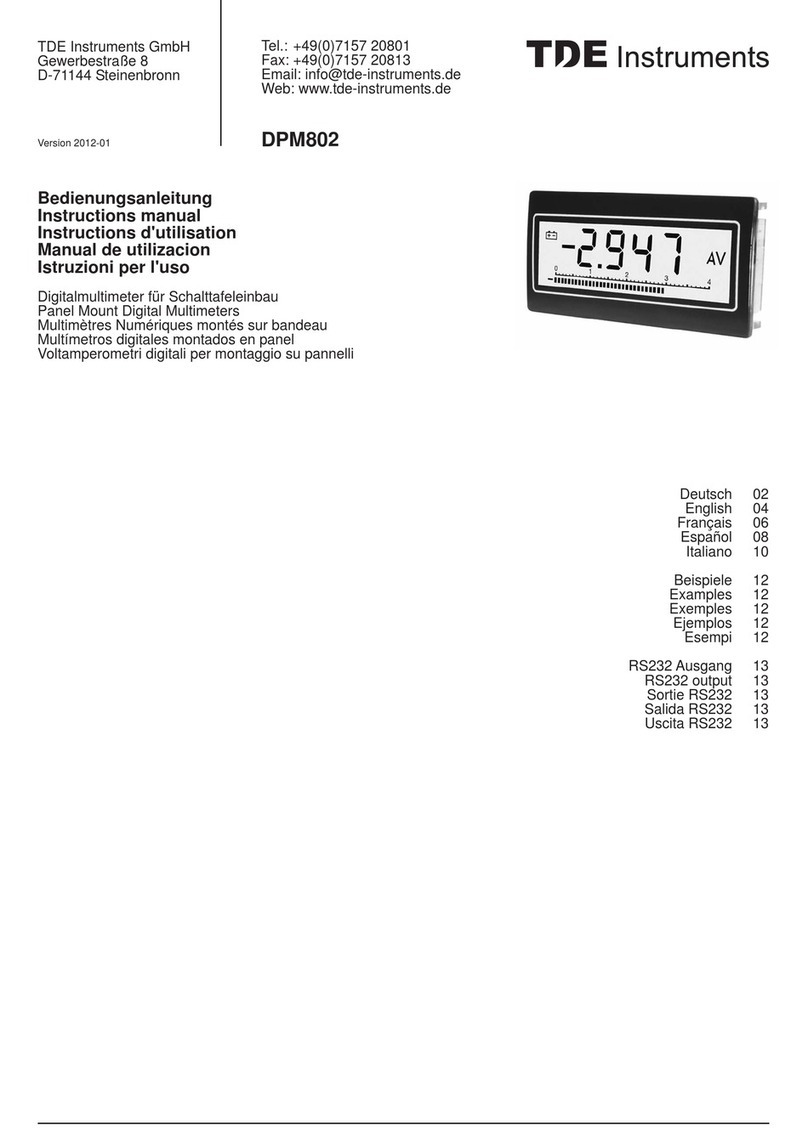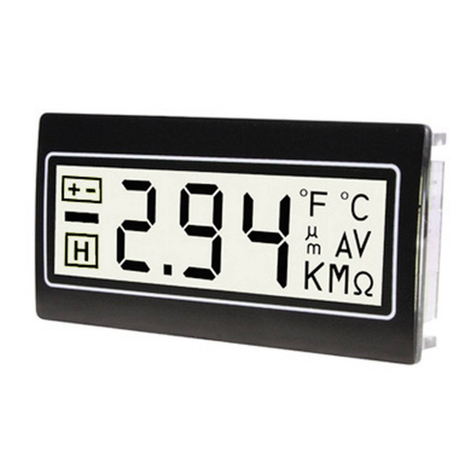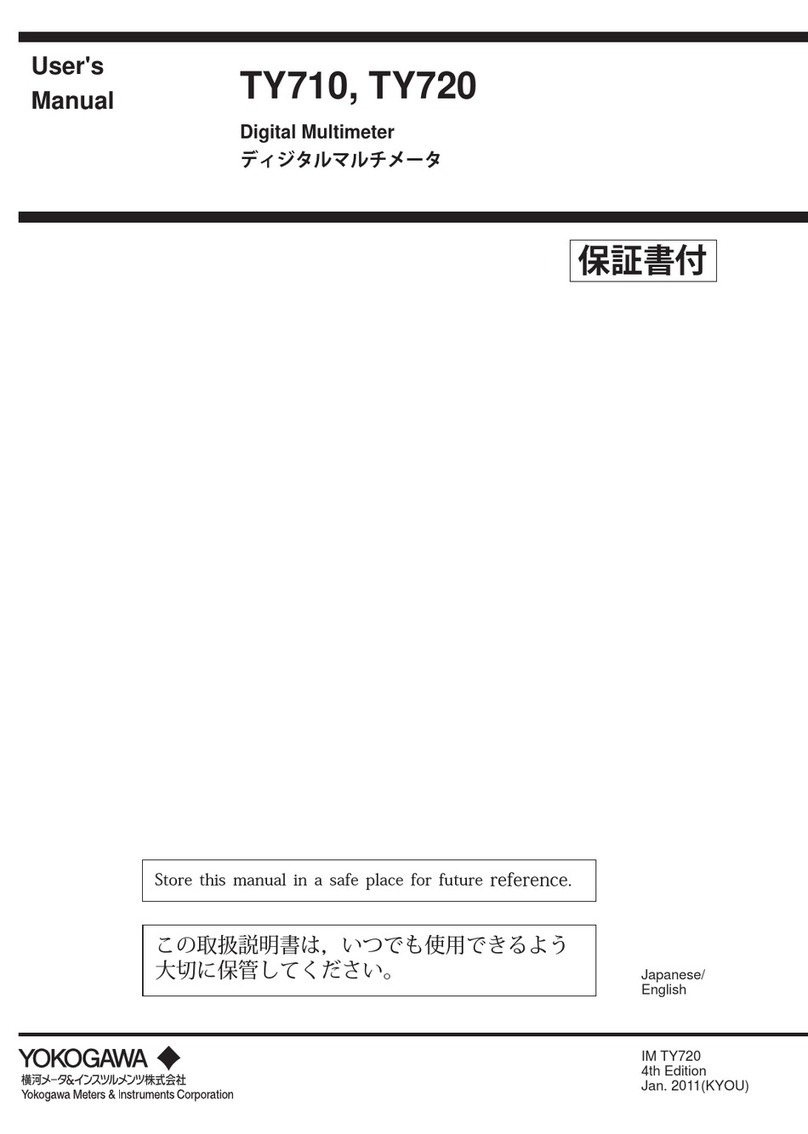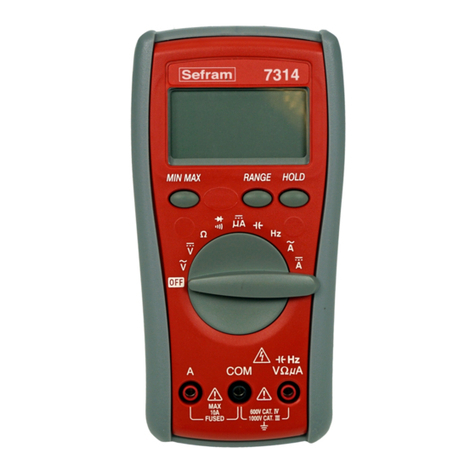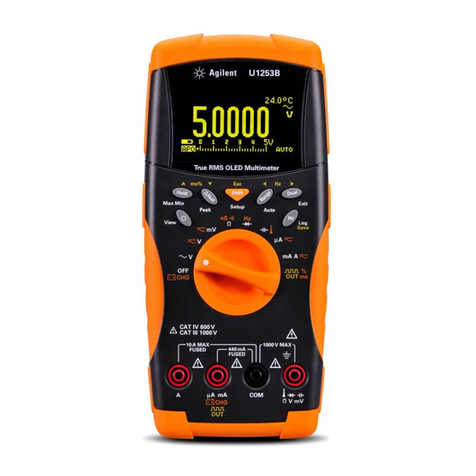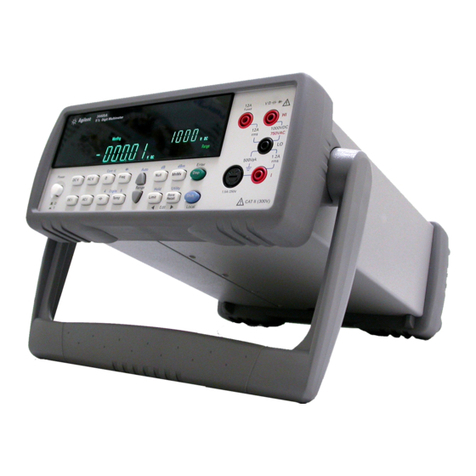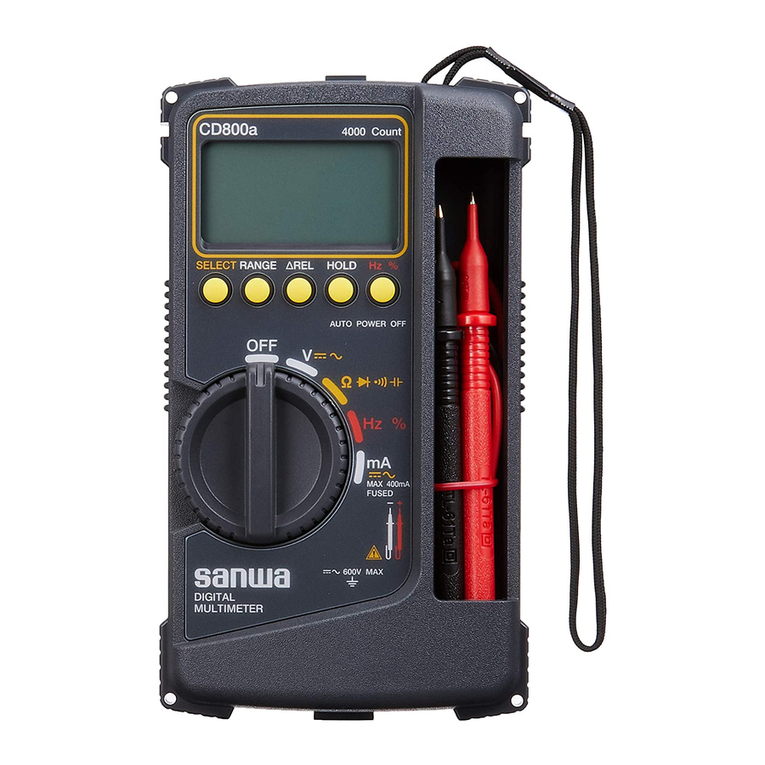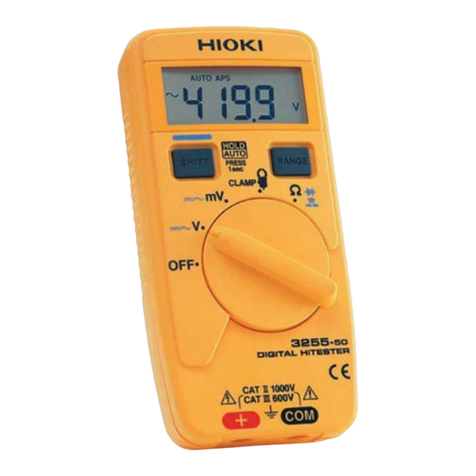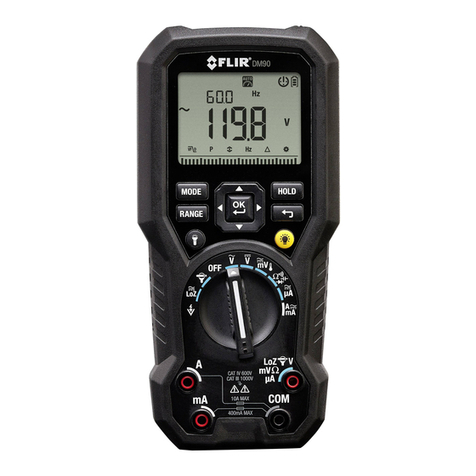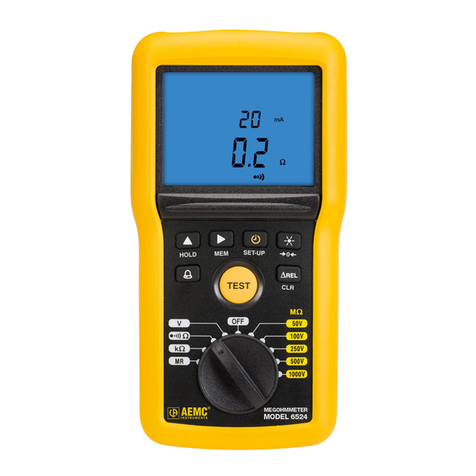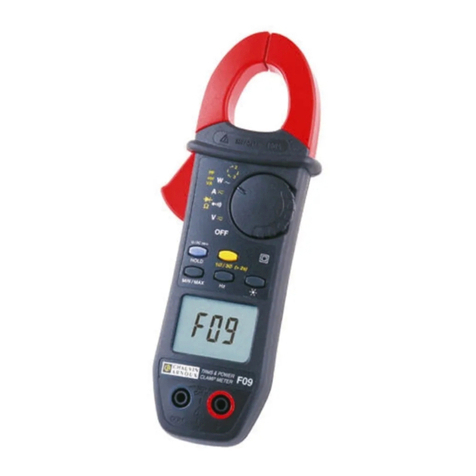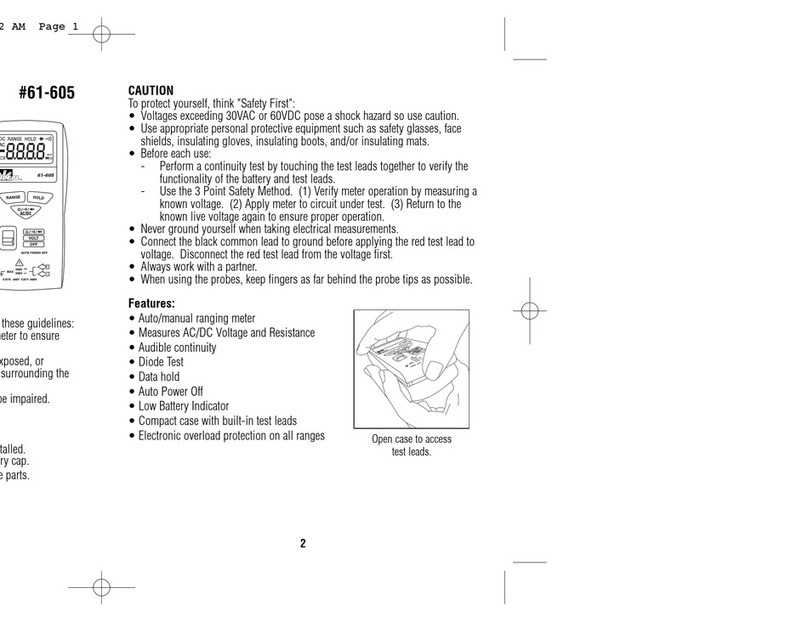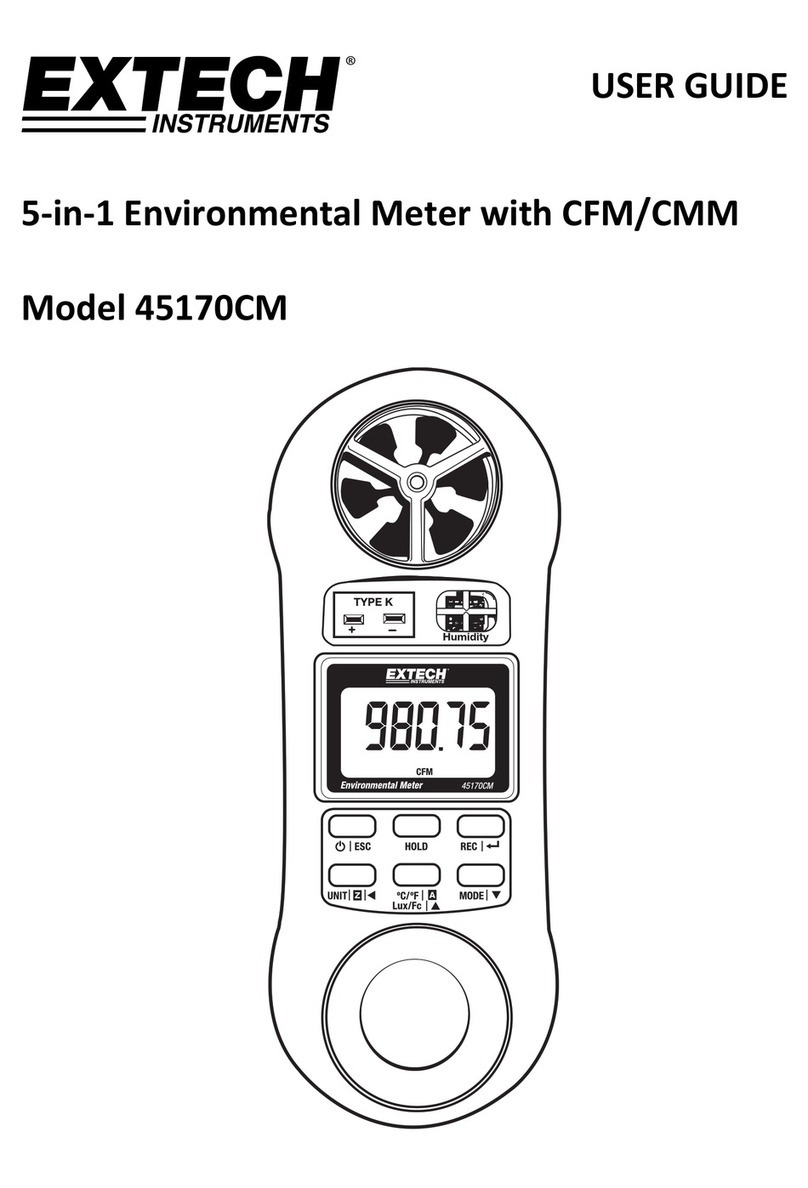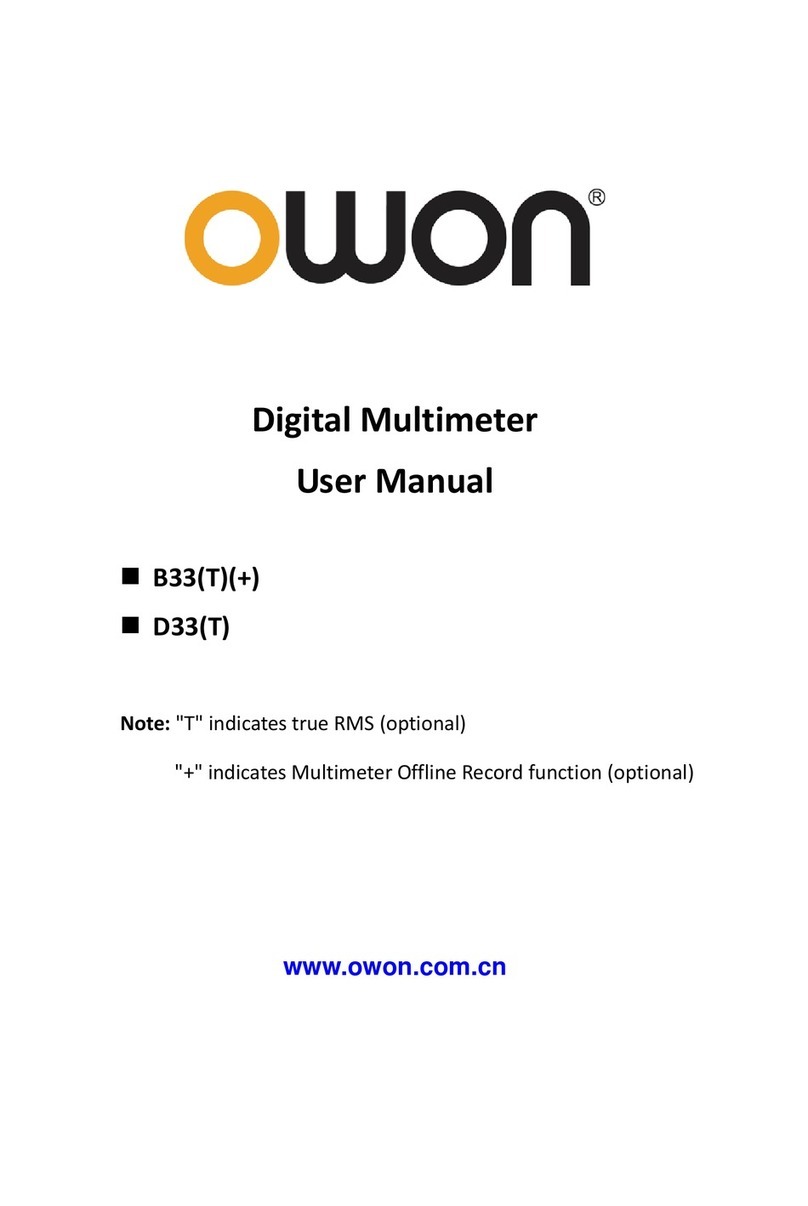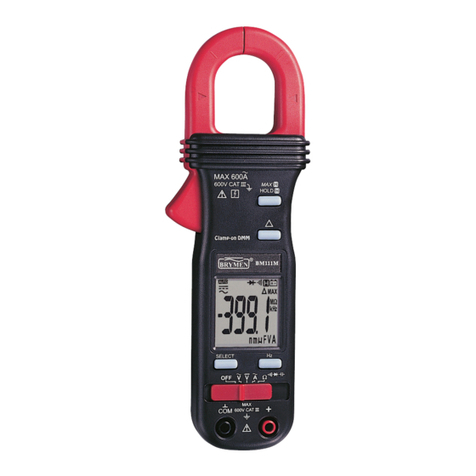TDE Instruments DPM802-TW User manual

DPM802
Version 2012-01
TDE Instruments GmbH
Gewerbestraße 8
D-71144 Steinenbronn
Tel.: +49(0)7157 20801
Fax: +49(0)7157 20813
Email: [email protected]
Web: www.tde-instruments.de
Bedienungsanleitung
Instructions manual
Instructions d'utilisation
Manual de utilizacion
Istruzioni per l'uso
Digitalmultimeter für Schalttafeleinbau
Panel Mount Digital Multimeters
Multimètres Numériques montés sur bandeau
Multímetros digitales montados en panel
Voltamperometri digitali per montaggio su pannelli
Deutsch
English
Français
Español
Italiano
Beispiele
Examples
Exemples
Ejemplos
Esempi
RS232 Ausgang
RS232 output
Sortie RS232
Salida RS232
Uscita RS232
02
04
06
08
10
12
12
12
12
12
13
13
13
13
13

1. Beschreibung
3 3/4-stelliges digitales Volt- und Ampèremeter
Einbauinstrument mit LCD Anzeige, LED Beleuchtung,
zusätzlicher 40 Segment Bargraphanzeige, Low Bat
Anzeige und RS232 Schnittstelle. Instrument
konfigurierbar für AC oder DC Messung.
Dieses Instrument hat eine automatische
Bereichsumschaltung bei einem Messbereich von
400mV bis 300V, sowie einen wählbaren
Eingangsstrommessbereich von 1µA bis 10A. Min. &
max. Werte werden abgespeichert und können
abgerufen werden. Die Versorgungsspannung beträgt
5V bis 16V DC.
2. Sicherheitshinweise
Die maximale Spannung, die an den
Messeingängen angelegt werden darf ist
300V. INLO (0 V) ist intern an VSS (0 V)
angeschlossen.
Hinweis:
Die Signalleitungen, die an dieses Gerät angeschlossen
werden, dürfen eine Gesamtlänge von 30m nicht
überschreiten. Werden Signalleitungen ausserhalb von
Gebäuden verlegt, müssen zusätzliche
Schutzmassnahmen gegen Surge Störimpulse
vorgesehen werden.
3. Technische Daten
Anzeige
Ziffernhöhe 11 mm; 40-Segment Balkenanzeige;
Vornullenunterdrückung; Low Bat; x10, x100, DC, AC,
µ, m, A, V, MIN, MAX
Eingangsbereich
± 0,1 mV bis 300 V; ± 0,1 µA bis 10 A
Genauigkeit
DC: V, µA, mA: ±1%
DC: A: ±3%
AC: 40–650 Hz: V, µA, mA: ±1%; A: ±3%
AC: 650–2700 Hz: ±5%
Linearität
± 0,1% Vollskala
Musterrate
1 Sek.
Eingangsimpedanz
V: 10 MΩ
0 bis 399,9 µA: 500 Ω
400 bis 3999 µA: 50 Ω
0 bis 39,9 mA: 5 Ω
40 bis 399,9 mA: 0,5 Ω
0 bis 10 A: 0,005 Ω
Anschlüsse
Messeingang: Schraubanschlüsse für Kabel bis
zu 1,5 mm²
Versorgung und Steuerung
2 x 5-polig 0,1" Abstand
Steuerungseingänge
Nur Sink oder Kontakt
RS232-Ausgang
2400 Baud, 7 Bit, ungerade Parität, 1 Stoppbit
Versorgung
5 bis 16 VDC ± 10%, max. 15 mA
Hintergrundbeleuchtung
5 bis 8 VDC oder 12 VDC ±0.5V; max. 110mA
Installationskategorie (IEC 664)
Überspannungskategorie II
Verunreinigungsgrad 2 (IEC 64)
Betriebstemperatur
0°C bis +60°C
Lagertemperatur
-20°C bis +70°C
Umgebungsschutz
IP50
Höhe
bis zu 3000 m
Relative Luftfeuchtigkeit
max. 85% nicht kondensierend
4. Leiterplatte
5. Konfiguration AC oder DC Messung an
Lötbrücke SB
SB offen = DC
SB geschlossen = AC
6. Anschluss Versorgung und Steuerung
an Stiftleiste CN1
1VDD 5 VDC bis 16 VDC
2VSS 0 V
3Hintergrundbeleuchtung BL+
4Hintergrundbeleuchtung BL-
5Gemeinsame Basis
6nicht angeschlossen
7Gemeinsame Basis
8MAX/MIN
9RS232-Trigger
10 RS232-Ausgang
7. Anschluss Versorgung Hintergrund-
beleuchtung an CN1
3 5 bis 8 VDC (Steckbrücke an BL setzen) oder 12
VDC.
4 0 V
8. Anschluss Messeingang an Schraub-
klemmen ST
1: INHI
±0,1 mV bis 300,0 V
±0,1 µA bis 3999 µA
±0,01 mA bis 399,9 mA
2: INHI
±0,01 A bis 10,0 A
3: INLO
0 V
!
3
2
1
10 8 6 4 2
9 7 5 3 1
SB
ST
BL CN1
CN2
CN3
02

03
9. Konfiguration Messbereich an CN2 und
CN3
±0.1mV - 300.0V
±0.1µA - 3999µA
±0.01mA - 399mA
±0.01A - 10A
10. Steuerungseingänge
Gemeinsame Basis (Pin 5 und 7) wird auf -3V gehalten.
NUR an Pin 8 oder 9 anschliessen.
11. RS232 Ausgang
Einen Widerstand wie nachstehend gezeigt extern
anschliessen.
12. RS232 Trigger
Um den RS232 Datenstrom zu starten, Pin 9 kurzzeitig
(100-1000 mS) mit Pin 5 oder Pin 7 verbinden. Um den
Datenstrom zu stoppen Vorgang wiederholen.
13. MAX/MIN-Modus
Um den MAX/MIN-Modus zu starten, Pin 8 kurzzeitig
(100 mS) mit Pin 5 oder Pin 7 verbinden. Um den
MAX/MIN-Modus zu beenden Pin 8 kurzzeitig (2 S) mit
Pin 5 oder Pin 7 verbinden.
0 aktueller Wert wird angezeigt
1 Zeigt vorherigen Höchstwert an
2 Zeigt vorherigen Mindestwert an
3 Zeigt aktuellen Wert an und beginnt mit der
Aufzeichnung neuer Höchst- und Mindestwerte
4 Zeigt neuen Höchstwert an.
5 Zeigt neuen Mindestwert an.
6 Zeigt aktuellen Wert an und beginnt mit der
Aufzeichnung neuer Höchst- und Mindestwerte.
usw.
exit Beendet MAX/MIN-Modus und zeigt aktuellen Wert
an.

1. Introduction
3 3/4 digit volt- and ammeter with a 40 segment bargraph
indication, LCD display, LED backlight, low bat indication,
and RS232 interface.
The unit has a fully auto ranging voltage input to 300
V and a selectable 4 scale ammeter up to 10A. Powerded
by 5 VDC up to 16 VDC and annunciators for units on
display which include min. and max. functions. Unit can
be configured for AC or DC measurement.
2. safety instructions
The maximum voltage allowed for any
connection to the PCB is 300V.
INLO (0V) is internally connected to VSS
(0V)
Note:
Any signal cables connected to this device must not
exceed 30 metres in length.
If signal cables are installed that are routed outside the
building, it will be necessary to install additional surge
protection devices.
3. Specification
Display
Digits 11 mm; 40-Segment bargraph; Leading zero
blanking; Low Bat; x10, x100, DC, AC, µ, m,A, V, MIN,
MAX
Input Range
± 0,1 mV bis 300 V; ± 0,1 µA bis 10 A
Accuracy
DC: V, µA, mA: ±1%
DC: A: ±3%
AC: 40–650 Hz: V, µA, mA: ±1%; A: ±3%
AC: 650–2700 Hz: ±5%
Linearity
± 0,1% full scale
Sample Rate
1 sec.
Input impedance
V: 10 MΩ
0 bis 399,9 µA: 500 Ω
400 bis 3999 µA: 50 Ω
0 bis 39,9 mA: 5 Ω
40 bis 399,9 mA: 0,5 Ω
0 bis 10 A: 0,005 Ω
Connections
Messeingang: Schraubanschlüsse für Kabel bis
zu 1,5 mm²
Power and control
2 x 5-way 0,1" spacing
Control inputs
Sink or contact only
RS232-output
2400 baud, 7 bit, odd parity, 1 stop bit
Supply
5 to 16 VDC ± 10%, max. 15 mA
Backlight supply
5 to 8 VDC or 12V DC ±0.5V; max. 110mA
Installation category (IEC 664)
Overvoltage category II
Pollution degree 2 (IEC 64)
Operating temperature
0°C to +60°C
Storage temperature
-20°C bis +70°C
Environmental protection
IP50
Altitude
Up to 3000 m
Relative Humidity
max. 85% non-condensing
4. PCB
5. Configuration AC or DC measuring at
solder strap SB
SB open = DC
SB shorted = AC
6. Connections Supply and control at socket
board at CN1
1VDD 5 VDC to 16 VDC
2VSS 0 V
3Backlight supply BL+
4Backlight supply BL-
5Control common
6not connected
7Control common
8MAX/MIN
9RS232-trigger
10 RS232 output
7. Connection backlight supply at CN1
3 5 to 8 VDC (set jumper at BL) or 12 VDC.
4 0 V
8. Connection Input at ST
1: INHI
±0,1 mV to 300,0 V
±0,1 µA to 3999 µA
±0,01 mA to 399,9 mA
2: INHI
±0,01 A to 10,0 A
3: INLO
0 V
04
!
3
2
1
10 8 6 4 2
9 7 5 3 1
SB
ST
BL CN1
CN2
CN3

05
9. Configuration measuring range at CN2
and CN3
±0.1mV - 300.0V
±0.1µA - 3999µA
±0.01mA - 399mA
±0.01A - 10A
10. Control inputs
Control Common (pins 5 and 7) is held at –3V. Do NOT
connect to any pin except pins 8 and 9.
11. RS232 output
Connect a resistor externally as shown below.
12. RS232 trigger
Connect Pin 9 with Pin 5 or Pin 7 (100 mS - 1000 mS)
once to start the RS232 data stream.
Repeat process to stop.
13. MAX/MIN-Mode
Connect Pin 8 with Pin 5 or Pin 7 (100 mS) to start
MAX/MIN-Modus.
Connect Pin 8 with Pin 5 or Pin 7 (2 S) to stop MAX/MIN-
Modus.
0 Displaying current value.
1 Displaying current value.
2 Displays previous minimum value.
3 Displays current value and starts recording new.
maximum and minimum values.
4 Displays new maximum value.
5 Displays new maximum value.
6 Displays current value and starts recording new.
maximum and minimum values etc.
exit Displays current value and starts recording new
maximum and minimum values.

1. Introduction
Multimètres analogiques/numériques à sélection
automatique de gamme, pour montage sur panneau
2. Instructions de sécurité
La tension maximale admissible pour tout
raccordement sur ce circuit imprimé est de
300V.
INLO (0 V) connectée en interne à VSS (0 V)
Remarque:
La longueur de tout câble mesure (signal) raccordé à
cet appareil ne doit pas excéder 30 mètres. Si les câbles
« mesure » passent à l'extérieur du bâtiment, il est
nécessaire d'installer des dispositifs additionnels de
protections de surtensions.
3. Caractéristiques
Caractéristiques
Caractères 11 mm; Vumètre à barres, 40 segments;
Remise à zéro de conduction; Indicateurs : pile faible,
x10, x100, CC, CA, -, µ, m, A, V, MIN, MAX
Gamme d'entrée
± 0,1 mV à 300 V; ± 0,1 µA à 10 A
Précision
CC: V, µA, mA: ±1%
CC: A: ±3%
CA: 40–650 Hz: V, µA, mA: ±1%; A: ±3%
CA: 650–2700 Hz: ±5%
Linéarité
±0,1 % pleine échelle
Fréquence test
1 s.
Impédance d'entrée
V: 10 MΩ
0 à 399,9 µA : 500 Ω
400 à 3 999 µA : 50 Ω
0 à 39,9 mA : 5 Ω
40 à 399,9 mA : 0,5 Ω
0 à 10 A : 0,005 Ω
Raccordements
Entrée : Connexions à vis protège-doigts pour fil jusqu'à
1,5 mm².
Alimentation et commande :
2 x 5 voies, espacement de 0,1"
Entrées de commande
Collecteur ou contact uniquement
Sortie RS232
2 400 bauds, 7 bits, parité impaire, 1 bit d'arrêt
Alimentation
5 à 16 VCC ±10 %, 15 mA max
Rétroéclairage
5 à 8 VCC / 12 VCC ±0.5V sélectionnable, 110 mAmax.
Catégorie d'installation (IEC664)
Catégorie surtension II
Degré de pollution 2 (IEC 64)
Température de fonctionnement
0°C à +60°C
Température de stockage
-20°C à +70°C
Protection environnementale
IP50
Altitude
usqu'à 3 000 m
Relative Humidity
85 % max., sans condensation
4. Cartes de circuits imprimés
5. Configuration AC ou DC mesure à SB
SB ouvert = CC
SB dérivés = CA
6. Raccordements Alimentation et
commande à CN1
1VDD 5 V CC à 16 V CC
2VSS 0 V
3Rétroéclairage BL+
4Rétroéclairage BL-
5Commande, commune
6non connectée
7Commande, commune
8MAX/MIN
9Déclencheur RS232
10 Sortie RS232
7. Raccordements Alimentation
rétroéclairage à CN1
3 5 à 8 VCC (placer pont à BL) ou 12 VCC.
4 0 V
8. Raccordements Entrée à ST
1: INHI
±0,1 mV à 300,0 V
±0,1 µA à 3999 µA
±0,01 mA à 399,9 mA
2: INHI
±0,01 A à 10,0 A
3: INLO
0 V
06
!
3
2
1
10 8 6 4 2
9 7 5 3 1
SB
ST
BL CN1
CN2
CN3

07
9. Configuration Gamme d'entrée CN2 et
CN3
±0.1mV - 300.0V
±0.1µA - 3999µA
±0.01mA - 399mA
±0.01A - 10A
10. Entrées de commande
Commande commune (broches 5 et 7) à -3 V. Ne PAS
connecter à quelque broche que ce soit, sauf aux
broches 8 et 9.
11. Sortie RS232
Brancher une résistance en externe, comme indiqué
ci-dessous.
12. Déclencheur RS232
Brancher à la commande commune une fois, pour lancer
le flux de données RS232. Brancher de nouveau à la
commande commune pour arrêter.
13. Mode MAX/MIN
0 Affichage de la valeur actuelle
1 Affichage de la valeur maximale précédente
2 Affichage de la valeur minimale précédente
3 Affichage de la valeur actuelle et enregistrement des
nouvelles valeurs maximales et minimales
4 Affichage de la nouvelle valeur maximale.
5 Affichage de la nouvelle valeur minimale.
6 Affichage de la valeur actuelle et enregistrement des
nouvelles valeurs maximales et minimales. etcc
exit Quitte le mode MAX/MIN et affiche la valeur actuelle.

08
1. Introducción
Multímetros analógicos/digitales con autocalibración
para montaje en panel
2. Observaciones de seguridad
El voltaje máximo permitido para cualquier
conexión al circuito impreso es 300V. INLO
(0 V) va conectadointernamente a VSS (0 V)
Nota:
Cualquier cable de señal conectado a esta unidad no
debe de exceder de 30 metros. Si se instalan cables
de señal que sean llevados fuera del edificio, sera
necesario instalar unidades adicionales de protección
de onda.
3. Especificación
Pantalla
61 mm x 18 mm; 4 caracteres de 11 mm; Gráfico de
barras de 40 segmentos; Se borran los ceros a la
izquierda; Anunciadores: batería baja, x10, x100, CC,
CA, -, µ, m, A, V, MÍN., MÁX
Rango de entrada
0,1 mV a 300 V
±0,1 µA a 10 A
Precisión
(±1 del dígito menos significativo)
CC: V, µA, mA: ±1%
CC: A: ±3%
CA: 40-650 Hz: como anterior
CA:650-2700 Hz: ±5%
Linearidad
±0,1% escala completa
Velocidad de muestreo
1 seg.
Impedancia de entrada
V: 10 MΩ
0 a 399,9 µA: 500 Ω
400 a 3999 µA: 50 Ω
0 a 39,9 mA: 5 Ω
40 a 399,9 mA: 0,5 Ω
0 a 10 A: 0,005 Ω
Conexiones
Entrada: Conexiones tornillo a prueba de dedos para
cables de hasta 1,5 mm².
Alimentación y control: 2 x 5 vías 0,1 pulg. paso
Entradas de control
Sólo absorción o contacto
Salida RS232
2.400 baudios, 7 bits, paridad impar, 1 bit de parada
Alimentación
5 a 16 VCC ± 10%, 15 mA máx
Luz de fondo
5 a 8 VCC / 12 VCC ±0.5V seleccionable, 110 mAmáx.
Categoría de instalación (IEC664)
Categoría II de sobrevoltaje
Grado de contaminación 2 (IEC64)
Temperatura de Funcionamiento
0° C a 60° C
Temperatura de almacenaje
-20° C a 70° C
Protección ambiental
IP50
Altitud
Hasta 3.000 m
Humedad relativa
85% máx. sin condensado
4. Circuito impreso
5. Configuración medición CC ó CA a SB
SB abierto = CC
SB acortados = CA
6. Conexiones alimentación y control a CN1
1VDD 5 V CC a 16 V CC
2VSS 0 V
3Luz de fondo BL+
4Luz de fondo BL-
5Control común
6no conectado
7Control común
8MÁX./MÍN. (ver la página 9)
9Disparo RS232
10 Salida RS232
7. Conexiones alimentación luz de fondo a
CN1
3 5 a 8 VCC (usar jumper a BL) ó 12 VCC.
4 0 V
8. Conexiones entrada a ST
1: INHI
±0,1 mV a 300,0 V
±0,1 µA a 3999 µA
±0,01 mA a 399,9 mA
2: INHI
±0,01 A a 10,0 A
3: INLO
0 V
!
3
2
1
10 8 6 4 2
9 7 5 3 1
SB
ST
BL CN1
CN2
CN3

09
9. Configuración campo de medición a CN2
y CN3
±0.1mV - 300.0V
±0.1µA - 3999µA
±0.01mA - 399mA
±0.01A - 10A
10. Entradas de control
Control común (clavijas 5 y 7) mantenido a -3V. NO
conectar a ninguna clavija, excepto la clavijas 8 y 9.
11. Salida RS232
Conectar una resistencia externa como se indica a
continuación.
12. Disparo RS232
Conectar a control común una vez para comenzar el
tren de datos RS232.
Conectar a control común otra vez para detener.
13. Modo MÁX./MÍN.
0 Indica el valor actual.
1 Indica el valor máximo anterior.
2 Indica el valor mínimo anterior.
3 Muestra el valor actual y empieza a registrar los
nuevos valores máximos y mínimos.
4 Indica el nuevo valor máximo.
5 Indica el nuevo valor mínimo.
6 Muestra el valor actual y empieza a registrar los
nuevos valores máximos y mínimos.
etc.
exit Sale del modo MÁX./MÍN. e indica el valor actual.

1. Introduzione
Multimetri digitali/analogici con montaggio a pannello
autoranging
2. Istruzioni di sicurezza
La tensione massima consentita per una
connessione su PCB è di 300V.
INLO (0 V) è collegato internamente a VSS
(0 V)
Nota:
Ogni cavo di segnale collegato a questo dispusitivo non
puo essere piu lungo di 30 metri. Se i cavi di segnale
sono installati su un percorso esterno all'edificio, è
necessario installare dispositivi di protezione di rete
addizionali.
3. Specifiche
Display
61 mm x 18 mm; Altezza cifre 4 x 11 mm; Grafico a
barre con 40 segmenti; Zeri non significativi soppressi;
Annunciatori: livello batteria basso, x10, x100, CC, CA,
-, µ, m, A, V, MIN, MAX
Gamme di ingresso
da ±0,1 mV a 300 V
da ±0,1 µA a 10A
Accuratezza
(±1 la cifra significativa minima)
CC: V, µA, mA: ±1%
CC: A: ±3%
CA: 40-650 Hz: come sopra
CA:650-2700 Hz: ±5%
Linearità
±0,1% della scala completa
Frequenza di campionamento
1 sec.
Impedenza d'ingresso
V: 10 MΩ
da 0 a 399,9 µA: 500 Ω
da 400 a 3999 µA: 50 Ω
da 0 a 39,9 mA: 5 Ω
da 40 a 399,9 mA: 0.5 Ω
da 0 a 10 A: 0.005 Ω
Collegamenti
Ingresso: collegamenti con viti di protezione per cavi
fino a 1,5 mm²
Alimentazione e controllo: 2 x 5 vie, spaziatura 0,1"
Ingressi di controllo
Solo contatto o sink
Uscita RS232
2400 baud, 7 bit, parità dispari, 1 bit di stop
Alimentazione
da 5 a 16 VCC ± 10%, 15mA max
Retroilluminazione
da 5 a 8 VCC/12 VCC ±0.5V selezionabile, 110 mAmax
Categoria di installazione (IEC664)
Categoria di sovratensione II
Grado di inquinamento 2 (IEC 64)
Temperatura di funzionamento
da 0°C a +60°C
Temperatura di immagazzinaggio
-da 20°C a +70°C
Protezione ambientale
IP50
Altitudine
Fino a 3000 m
Umidità relativa
85% max (senza condensa)
4. PCB
5. Configurazione misurazione CC o CA a
SB
SB aperto = DC
SB cortocircuitato = AC
6. Collegamenti alimentazione e controllo
a CN1
1VDD da 5 VCC a 16 VCC
2VSS 0 V
3Retroilluminazione BL+
4Retroilluminazione BL-
5Controllo comune
6Non collegato
7Controllo comune
8MAX/MIN (vedere pagina 10)
9Trigger RS232
10 Uscita RS232
7. Collegamenti alimentazione
retroilluminazione a CN1
3 da 5 a 8 VCC (Usare jumper a BL) a 12 VCC.
4 0 V
8. Collegamenti ingresso Misurazione a ST
1: INHI
±0,1 mV a 300,0 V
±0,1 µA a 3999 µA
±0,01 mA a 399,9 mA
2: INHI
±0,01 A a 10,0 A
3: INLO
0 V
10
!
3
2
1
10 8 6 4 2
9 7 5 3 1
SB
ST
BL CN1
CN2
CN3

11
9. Configurazione gamme di misurazione
a CN2 e CN3
±0.1mV - 300.0V
±0.1µA - 3999µA
±0.01mA - 399mA
±0.01A - 10A
10. Ingressi di controllo
Il controllo comune (pin 5 e 7) viene mantenuto a -3 V.
Collegare SOLO ai pin 8 e 9.
11. Uscita RS232
Collegare un resistore esterno, come mostrato di seguito.
12. Trigger RS232
Collegare al controllo comune una volta avviato il flusso
di dati RS232.
Collegare nuovamente al controllo comune per arrestare.
13. Modalità MAX/MIN
0 Visualizza il valore corrente.
1 Visualizza il valore massimo precedente.
2 Visualizza il valore minimo precedente.
3 Visualizza il valore corrente e avvia la registrazione
dei nuovi valori massimo e minimo.
4 Visualizza il nuovo valore massimo.
5 Visualizza il nuovo valore minimo.
6 Visualizza il valore corrente e avvia la registrazione
dei nuovi valori massimo e minimo.
ecc.
exit Esce dalla modalità MAX/MIN e visualizza il valore
corrente.

12
Anwendungsschaltungen, Application Circuits, Circuits Integres pour les Applications,
Circuitos De Aplicación, Circuiti Di Applicazione
DC Spannung, Voltage, Tension, Voltaje, Tensione
AC Spannung, Voltage, Tension, Voltaje, Tensione
DC Strom, Current, Courant, Corriente, Corrente
!Elektrischer Verbraucher, electrical load, charge
électrique, carga eléctrica, carichi elettrici
AC Strom, Current, Courant, Corriente, Corrente
!Elektrischer Verbraucher, electrical load, charge
électrique, carga eléctrica, carichi elettrici

13
1. Serial Data output
The serial data is sent to the data output pin (pin 10)
twice every A/D conversion cycle. The data format
complies with JIS 7BIT transmission code with a baud
rate of 2400. The host can use the RS232 interface to
read the data. A single data packet allows a start bit
(always 0), 7 data bits, an odd parity check bit, and a
stop bit (always 1). The high and low voltage levels
correspond to +V and -3V respectively. The serial output
remains at 1 (high) when it is inactive. Hence the start
bit (0) could be used as the triggering signal to begin
the reading process. The following figure shows the
data format of a single packet. The LSB is sent first
and the MSB is sent last.
One data block consists of 11 packets, or 110 bits. The
following figure shows the format of a data block. The
range packet indicates the full scale range of the meter.
Digit 3 through to digit 0 represent the digits on the
meters display. The function packet indicates the
measurement mode of the meter. Status, option 1, and
option 2 give the status of the meter. CR and LF are
delimiters used to separate the blocks.
The meter always outputs the current input value to the
serial port regardless of whether the hold function has
been activated or not. Each block is repeated twice in
one conversion cycle. The detailed data format of each
packet is listed below.
2. Function
This packet indicates the measurement mode of the
meter. The following table summarises the transmitted
code for each mode. Note that the encoding of this
packet is different to the encoding of the FC1 to FC4
switch.
3. Range
This packet indicates the full scale range of the meter.
When the meter is in current mode (A) this packet is
always 0110000 since the full scale range in this mode
is fixed. The following table shows the codes for each
range.
4. Digit 3 to digit 0
Digit 3 is the most significant digit on the LCD panel,
and the digit 0 is the least significant digit. When the
LCD panel shows OL the serial port outputs 4000.
5. Status
The format of this packet is shown below. (The judge
field is not applicable to these units, but will be present
in the data field- it should be disregarded). The sign
field indicates whether the minus sign on the LCD is
ON or OFF. The Batt field indicates if the battery low
condition is true. OL indicates input overflow.
6. Option 1
This packet contains information on special measurement
modes. The format of this packet is shown below. The
three none constant fields are set to "1" when the meter
operates in the corresponding special modes, max and
min. Bit 0 (VAHZ) is not applicable.
01
LSB MSB
0 1 0 1 0 1
0 1 0 1 0 1
0 1 0 1 0 1
0 1 0 1
range digit3 digit2
digit1 digit0 function
status option1 option2
CR LF
Code Measurement Mode
0111011 Voltage
0111101 µA Current
0111001 mA Current
0111111 A Current
0111110 ADP0
0111100 ADP1
0111000 ADP2
0111010 ADP3
Code V mA µA
0110000 400.0 mV 40.00 mV 400.0 µA
0110001 4.000 V 400.0 mA 4000 µA
0110010 40.00 V
0110011 400.0 V
0110100 4000 V
0110101
Digit Code
0 110000
1 110001
2 110010
3 110011
4 110100
5 110101
6 110110
7 110111
8 111000
9 111001
0 1 1 Judge Sign BATT OL
Bit 6 Bit 5 Bit 4 Bit 3 Bit 2 Bit 1 Bit 0
0 1 1 Pmax Pmin 0 VAHZ
Bit 6 Bit 5 Bit 4 Bit 3 Bit 2 Bit 1 Bit 0

14
7. Option 2
This packet contains information on the operating mode
of the meter. The format of this packet is shown below.
The DC field indicates that the meter operates in DC
mode, measuring voltage or current.
The AC mode indicates that the meter operates in AC
mode, measuring voltage or current. The APO field is
not applicable.
8. CR
Carriage Return. The transmitted code is 0001101
9. LF
Line Feed. The transmitted code is 0001010
0 1 1 DC AC AUTO APO
Bit 6 Bit 5 Bit 4 Bit 3 Bit 2 Bit 1 Bit 0

15
Abmessungen
Dimensions
Dimensiones
Dimensioni
PANEL CUT-OUT
33 x 68mm +0.5 / -0.0
(1.3 x 2.68”'94 +.02 / -0.0)

TDE Instruments GmbH
Gewerbestraße 8
D-71144 Steinenbronn
Tel.: +49(0)7157 20801
Fax: +49(0)7157 20813
Email: info@tde-instruments.de
Web: www.tde-instruments.de
This manual suits for next models
2
Table of contents
Languages:
Other TDE Instruments Multimeter manuals
